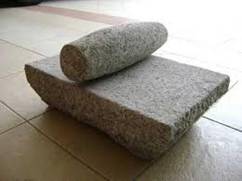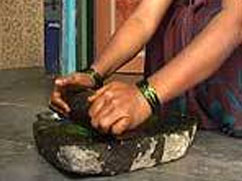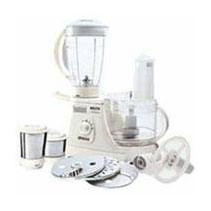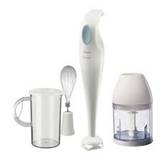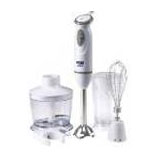A mixer is a kitchen appliance used for mixing, folding, beating, and whipping food ingredients. Mixers come in two major variations, hand mixers and stand mixers.
Hand Mixer
This is usually available as a manually-operated type. Hand mixers preceded electric mixers and are still used today. A hand mixer consists of a handle with a hand-operated crank on the side, geared to two beaters. The handle is held with one hand and the crank is turned with the other, turning the beaters which act on the food ingredients.
The electrically powered type is a present day innovation of the same hand mixer concept. This eliminates the use of manual work and makes it very easy to operate and in a much lesser time too. It consists of a handle mounted over a large enclosure containing the motor, which drives one or two beaters by the mere pressing of a button. The beaters are immersed in the food to be mixed. Various attachments – each shaped differently are provided with a hand mixer to perform the mixing, folding, beating and whipping operations specifically.
Handheld electric mixer with various attachments
Stand Mixer:
A stand mixer is essentially same as a hand mixer, but is mounted on a stand which bears the weight of the device. Stand mixers are larger and have more powerful motors than the hand-held ones. They usually have a special bowl that is locked in place while the mixer is operating.
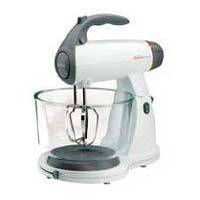
Stand Mixer
[Image source]
Mixers are very different from blenders. Blenders contain sharp blades and operate at higher speeds compared to mixers and are used more to chop, liquefy, or break down larger food items. A mixer is a much slower device without sharpened blades.
Grinders / Food Processors
A food processor is a kitchen appliance used to facilitate various repetitive tasks in the process of preparation of food. The term almost always refers to an electric-motor-driven appliance in the present day.
The idea of a machine to process food began when a French catering company salesman, Pierre Verdun, observed the large amount of time his clients spent in the kitchen chopping, shredding and mixing. He produced a simple but effective solution, a bowl with a revolving blade in the base. In 1960, this evolved into Robot-Coupe, a company established to manufacture the first commercial "food processor" for the catering industry. Further trials by various people at different times across the world helped evolve the present day grinder/ food processor.
Fuctions
Food processors normally have multiple functions, depending on the placement and type of attachment or blade. These functions normally consist of:
• Slicing/chopping vegetables
• Grinding items such as nuts, coconut kernel, seeds (e.g. spices), meat, etc
• Shredding or grating cheese or vegetables
• Pureeing
• Mixing and kneading dough
Design and Operation
The base of the unit houses a motor which turns a vertical shaft. A bowl, usually made of transparent plastic, fits around the shaft. Cutting blades can be attached to the shaft; these fit so as to operate near the bottom of the bowl. Shredding or slicing discs can be attached instead; these spin near the top of the bowl. A lid with a "feed tube" is then fitted onto the bowl.
The feed tube allows ingredients to be added while chopping, grinding or pureeing. It also serves as a chute through which items are introduced to shredding or slicing disks. A "pusher" is provided, sized to slide through the feed tube, protecting fingers.
Almost all modern food processors have safety devices which prevent the motor from operating if the bowl isn't properly affixed to the base or if the lid isn't properly affixed to the bowl. These are available as both manually operated models and electrically operated ones.
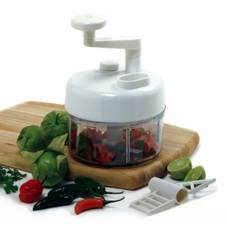
A crank-operated food processor
[Image source]
Food processors in India
If one takes a look into the Indian Kitchen, one can see the changes that have come in, especially in the ways of cooking. The difference between a traditional and modern kitchen seems quite a bit, as earlier there were very few kitchen aids available and every homemaker had to perform most of the cooking tasks on their own.
Sil Batta
Every Indian kitchen had the stone-grinder popularly known as Sil Batta about a few decades ago. The sil is a flat stone and the batta is a smaller cylindrical stone, a little like a rolling pin, which is rolled and pressed over the spices to grind and combine them. Spices are a core ingredient in Indian cooking and the ritual of preparing and grinding the spices took place every day, fresh for each meal using a Sil Batta.
The Sil Batta holds its own significance, one it is a good form of vigorous exercise for the arms, and the diehard believers feel that the authentic taste that it imparts to the freshly ground spices cannot be imitated by any other kitchen aid.
But it has slowly been replaced with the electric grinder/mixer for the convenience and time saving capabilities for working women.
Though unique, Sil Batta has its own identity. Though it may have disappeared from an urban kitchen it still is the main equipment used for grinding spices in a rural or a low income home.
Food Processors:
The food processor is a modern kitchen accessory without which it becomes hard for a home maker to perform the cooking tasks. It is also known as a mixer or grinder in India.
There are many well known brands in the Indian mixer/grinder market, like - Philips, Kenstar, Jaipan, Inalsa, Sumeet, Bajaj, Meenumix, Butterfly etc. All of them over the years have made commendable additions and improvements to their mixers and grinders. The latest mixers and grinders not only are efficient in grinding the food items but are also used as juicers in kitchens hence “Food Processor” is the present avatar of an all-in-one mixer+ grinder + juicer. The Indian consumer is very happy to have acquired a single device for doing all the cumbersome kitchen jobs (especially suited for the Indian style of cooking) rather than having two or three different equipment to help in the kitchen.
With these latest food processors the task of chopping raw vegetables, preparing dough and getting evenly mixed vegetable mixture has become a task of seconds.
Food processors now come with a slew of latest functions like assorted multi functional blades discs and jars, multi speed levels, unbreakable attachments, and finish all the pre- cooking tasks to perfection in seconds. With the synergy of modern compact looks, powerful performance and multi utility functions, food processors or juicers+mixers+ grinders save space, time and effort.
Design
The food processers are incorporated with many innovative and advanced technological features that ease the process of cooking for a home maker, making it easier and pleasurable. This is a small unit which will take up very little space in the kitchen in comparison to the amount of work it does.
It comes with different jars, discs and blades for different purposes. The jars are made up of Polycarbonate and Stainless Steel. The jar handles are made of ABS. The blades are made of hardened stainless steel. This gives them a rust free longer life.
Key Features
Food Processor is a device that helps a lot while doing kitchen work. It cuts short the time one spends in the kitchen by about half. The processor comes with different kinds of blades like Dry Grinding blade, Wet Grinding blade, Chutney blade, Whipping blade and Mincing or Grating blade, Kneader blade, Universal blade (It is a blade which does all kinds of grinding, blending and mixing) etc, all with different usage.
The food processor consumes around 600 watts of power, which is very economical on the energy consumption. It does not increase domestic electricity bills. The device works with the power supply of 230V single phase.
Some food processors have a 90 degree 3 speed ergonomic switch with incher facility which is a very useful feature.
Sometimes an ‘over load protection’ switch for the motor which protects the food processor is present in some models.
Some of them have a cord winding facility for easy storage of the electric cord.
Food processors come with a maximum of 7 accessories to perform 25 functions. They are: a stainless steel blade for chopping, beating, creaming, crumbling, cutting, folding in, mashing, mincing, mixing; a kneading tool for (heavy) kneading; a slicing insert for medium slicing of vegetables and fruit either coarse or fine; a shredding insert for medium shredding of vegetables, fruit and cheese either coarse or fine; an emulsifying disc for whipping, whisking, emulsifying; a granulating insert for granulating potatoes; and a blender for blending, crushing, foaming, grinding, (heavy) pureeing, homogenising, liquidising, milling, shaking, stirring.
Accessories
Usually, different jars are provided with a food processor to carry out various functions. These jars are the Liquidizer or Blender Jar (1 litre capacity usually), Chutney Jar (0.4 litre capacity usually) and Grinding Jar for both wet and dry grinding (1 litre capacity usually).
With the liquidizer jar one can prepare milkshakes, and purees, within seconds. With the chutney jar one can make different kinds of chutneys quite fast. The grinding jar is for different kinds of grinding. The juicer has the following attachments- Bowl, Pulp Container and Food Pusher.
Some extra attachments that are provided by some manufacturers are: Processing blade holder, Safety cover, Centrifugal juicer attachment, Citrus juicer attachment, Spatula etc.
Some Indian brands of food processors which have evolved into modern products:
Blenders
A blender or liquidiser is a kitchen appliance used to mix ingredients or puree food.
Blenders are different from lower-speed hand-powered or electric mixers that are used for mixing applications. The term typically refers to a stationary, upright electrical device, but hand-held immersion blenders have become common in recent years.
The hand-held immersion blender has no container of its own, but instead has a mixing head with rotating blades that can be immersed in a container.
Food processors are similar to blenders in many ways. The primary difference is that food processors use interchangeable blades and disks (attachments) instead of fixed blades. Also, their bowls are wider and shorter, a more appropriate shape for the solid or semi-solid foods usually worked in a food processor. Usually little or no liquid is required in the operation of the food processor unlike a blender, which requires some amount of liquid to move the particles around its blade.
Blenders also have a variety of applications in microbiology and food science. In addition to standard food-type blenders, there is a variety of other configurations of blenders for laboratories.
Hand-held Blender:
An immersion blender, or 'stick blender' is a kitchen appliance to blend ingredients or puree food in the container in which they are being prepared. They are sometimes called stick blenders, wand blenders, and hand blenders. They may be used for pureeing soups and emulsifying sauces. Some can be used while a pan is on the stove.
Immersion blenders are distinguished from blenders and food processors that require food be placed in a special vessel for processing. They are distinguished from hand mixers which do not chop the food as it is blended.
The immersion blender was invented in Switzerland by Roger Perrinjaquet, who patented the idea on March 6, 1950. He called the new appliance "bamix", a portmanteau of the French "bat et mixe" (beats and mixes). The immersion blender has been in use in European professional kitchens since the 1960s, and was adopted for home use in the United States market in the 1980s.
Development
The Polish-American Stephen J. Poplawski, an owner of the Stevens Electric Company, began designing drink mixers in 1919 under contract with Arnold Electric Company and patented the drink mixer in 1922 which had been designed to make Horlicks malted milk shakes at soda fountains. He also introduced the liquefier blender in 1922.
Since then numerous models have been designed and several modifications have been made to arrive at the popular present day versions that are available now.
With the rising popularity of smoothies, Frappucinos and other frozen drinks prepared in front of the customer, new models of commercial blenders often include a sound-reducing enclosures and computerized controls.
Indian Brands
Some Indian brands of handheld blenders are shown below. These have been designed taking into consideration the requirements of the Indian style of cooking.
There are a number of attachments available with the hand blenders depending upon different uses and prices. Cooking gets so easy with the hand blenders, it does not occupy much of space and the wall holder allows it to be positioned against a wall easily.
Some special features of some popular Indian blender brands are
• 600 watts/400 watts DC motor
• 2 Speed Soft Push Button
• Variable Speed Control
• Easy Locking System
• Comes with beaker, chopper and whisker attachment
• Slim ergonomic design
• Rubber mat provided for chopper and beaker
• Universal blade for multiple functions
• Detachable stainless steel leg for easy cleaning
• Comfortable grip for ease of use
• Wall mountable
Design
The basic handheld food processor has a sleek white body that houses the motor. The unit has a stainless steel leg with 4 detachable attachment blades. The Beaker Accessory acts as a blender jar and also works as a measuring cup. As an innovation it also has a chutney attachment to give one a complete package. The twin speed on/off switch must be pressed while using the appliance. This lightweight hand blender gives a good grip to one’s hands. It takes no counter space as it comes with a wall-bracket.
Models for home use usually have a shaft of ten to twelve inches, but models are available for professionals with a shaft up to two feet. Home models are available in corded or cordless versions.
Key Features
The wide variety of blade attachments makes the blender perfect equipment for an Indian kitchen. With 160 watts of power and a speed range of 12000 r. p.m, all the tasks are performed efficiently. The four different blades handle blending, whisking, chopping, mincing and slicing seamlessly. The beaker can be used for soups, shakes and juices. The chutney jar can be used also for chopping and mincing.
Pros
The hand blender is equipped with a unique fruit filter accessory that will filter skins, pulps and seeds from your freshly made juices. With such great, easy- to- clean, easy to use features, it proves to be a good cocktail assistant.
Cons
The power input is low for such multi-functions.
With versatile attachments, easy-to-use features the blender is a preferred choice in some households to the food processor. As the hand blender is clutter free and has easy maintenance, one can save a good amount of money and energy by investing on it.
Applications:
Blenders are used both in home and commercial kitchens for various purposes, such as:
• Making soups, juices, whipping creams, churning butter, chopping onions, garlic, grinding onions, for the Indian way of cooking
• Mix and crush ice in cocktails such as the Piña Colada and frozen margaritas
• Crush ice and other ingredients in non-alcoholic drinks such as Frappucinos and smoothies
• Make smooth purées of semi-solid ingredients, such as cooked vegetables and meat
• Reduce small solids such as spices and seeds to powder
• Blend mixtures of powders, granules, and/or liquids thoroughly
• Help dissolve solids into liquids












